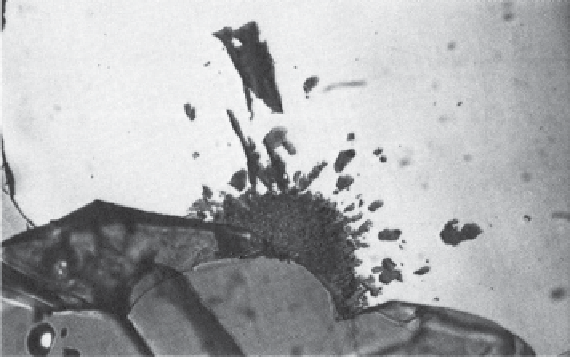Geology Reference
In-Depth Information
Acapulcoite
8.59 g
Found December 27, 1977
2.0 × 2.0 × 2.5 cm
Weathering = B
and H chondrites, roughly chondritic mineralogies, achondritic, equigran-
ular textures, micrometer- to centimeter- sized veins of Fe,Ni-FeS that
cross-cut silicate phases, rapid metallographic cooling rates at ~600-400°C
(10
3
-10
5
°C/Myr), and trapped noble gas abundances comparable to type
3-4 ordinary chondrites. They likely formed from a precursor chondrite
that differs from known chondrites in mineral and oxygen isotopic com-
positions. Heating to ~950-1000°C resulted in melting at the Fe,Ni-FeS
cotectic, but silicates did not melt. Silicate textures resulted from extensive
solid-state recrystallization. Acapulcoites share a common mineralogy,
mineral composition, and oxygen isotopic composition with lodranites
and are believed to have originated on a common parent body.
Plate 40
MiNERALogy
SigNiFiCANCE
ALH A77081 is a moderately coarse equigranular (grains
0.1-0.3 mm diameter) aggregate of approximately equal
amounts of olivine (Fa
11
) and orthopyroxene
( Wo
1.7
Fs
11
En
87
), with minor amounts of diopside
( Wo
45
Fs
5
En
50
) and plagioclase (An
15
) with 0.8% K
2
o,
nickel-iron metal, troilite, graphite (above, growing into
kamacite, [267]), and accessory chromite.
ALH A77081 was the first U.S. Antarctic meteorite
grouped with the acapulcoites and lodranites. originally
described as H7 chondrites, careful petrographic examina-
tion revealed micron-sized veins of metal and sulfide indic-
ative of the earliest partial melting of an asteroid. These
veins, formed when low-degree partial melts produced
excess pressures and minute fractures, record the onset of
transformation of chondritic bodies to the differentiated
worlds that dominate the inner solar system today.
References [260-269]




